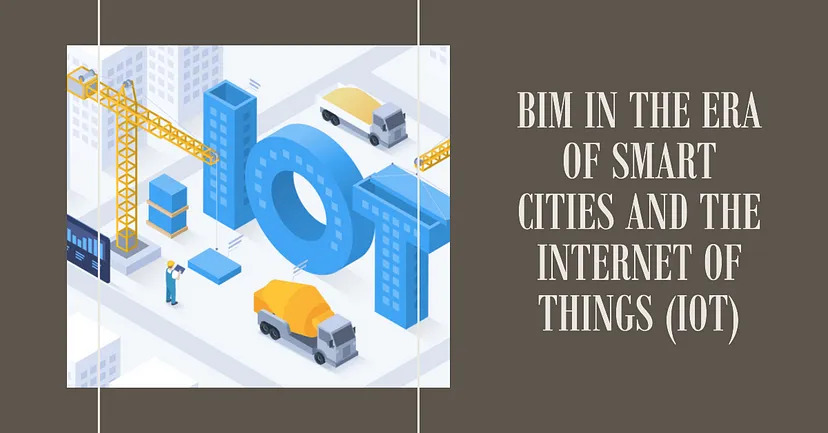
The world of construction is steadily evolving, and with it, urban planning is also undergoing a significant transformation. As new technologies are adopted, we are witnessing a gradual yet powerful shift in the way we approach urban development.
In this article, we explore the intersection of three exciting technological approaches: BIM, the Internet of Things (IoT), and smart cities. We will discuss what smart cities are all about and how BIM and IoT technology are used to bring them to life.
What is a Smart City, BIM and IOT?
Before we go any further, we need to understand these concepts on a basic level. BIM Modeling Services play a crucial role in creating digital 3D models of buildings, incorporating comprehensive data that aids in fostering collaboration among stakeholders. On the other hand, Smart Cities leverage advanced technologies and vast data resources to improve sustainability, efficiency, and the overall quality of life for residents. Additionally, the Internet of Things (IoT), an extensive network of interconnected devices and sensors, collects and exchanges data for intelligent decision-making and automation.
Understanding the goals of creating a Smart City
The primary goal of a smart city is to optimize city functions and improve the quality of life for citizens. It could be difficult to classify what a smart city is as there are no set standards; however, we can start with some objectives of creating smart cities, such as:
- Optimizing the different city functions, for smoother day to day operation.
- Promoting economic growth sustainably.
- Improving the quality of life for citizens, by providing better comfort and healthcare.
- Increasing safety and security without hindering freedom of movement.
- Reducing the use of energy and carbon emissions to reduce the negative impact on the environment.
Here are some ways in which these goals can be achieved:
Smart Infrastructure: Smart cities use technology to optimize infrastructure, including transportation, energy, healthcare, and waste management services. This includes the use of sensors and data analytics to improve efficiency and reduce costs.
Real-Time Data: City functions in smart cities can be managed more effectively by monitoring real-time data. This includes data from sensors, cameras, and other devices that can be used to track traffic, air quality, energy usage, and other key indicators.
Data Analytics: The use of machine learning and artificial intelligence to analyses large datasets and identify patterns and trends helps to optimize city functions in smart cities.
Automation: In smart cities, technologies such as self-driving taxis, automated kiosks, smart parking, and automated waste management systems will dramatically improve the lives of the inhabitants.
Renovation and refurbishment: Powerful tools such as Scan to BIM can help in the renovation and restoration of old or damaged buildings. Historical and cultural buildings can be renewed or reconstructed completely using Scan to BIM Services. The iconic Notre Dame cathedral in Paris, which was destroyed due to a fire, is being rebuilt using scan to BIM and CAD tools.
Real-World Case Studies of Successful BIM and IoT Implementations in Smart Cities
Barcelona, Spain: The city of Barcelona utilized BIM models to optimize urban planning and infrastructure design. IoT sensors were deployed to collect useful data on energy usage, waste management, and transportation. This integration improved efficiency in resource allocation, reduced energy consumption, and enhanced waste collection routes.

Singapore: Singapore cleverly leveraged BIM and IoT to transform into a smart city. BIM models were used to plan and manage urban development projects, while IoT sensors enabled real-time data collection for traffic management and environmental monitoring. This integration enhanced transportation efficiency, reduced congestion, and improved air quality in the city.
Copenhagen, Denmark: Copenhagen implemented BIM and IoT technologies in their sustainable city initiatives. BIM models were used to design energy-efficient buildings and infrastructure. IoT sensors were employed to monitor energy usage, optimize waste management, and improve public transportation. This integration resulted in reduced energy consumption, improved waste management practices, and enhanced mobility options for citizens.
Challenges and Considerations in the Integration of IoT Systems
- Implementation complexity: Integrating BIM and IoT systems in smart cities requires extensive coordination among diverse stakeholders, including architects, engineers, urban planners, and technology providers. The complexity of managing these collaborations is quite challenging.
- Data interoperability: It is difficult to achieve seamless data exchange between different BIM and IoT platforms and devices. The compatibility and interoperability of diverse systems need to be addressed before these systems can be adopted on a large scale.
- Cost implications: The adoption and maintenance costs of BIM and IoT technologies can be substantial, particularly for cities with budget constraints. Securing necessary funding and managing long-term costs are important considerations.
- Privacy concerns: The integration of BIM and IoT involves collecting and analyzing vast amounts of personal and sensitive data. This raises concerns about privacy infringement. Implementing robust data protection is necessary to protect privacy rights.
- Cybersecurity risks: IoT devices and networks are potential targets for cyberattacks. Implementing robust cybersecurity measures such as encryption, access controls, and regular assessments, is extremely important to ensure safety.
Conclusion
After considering the above discussed factors, we can conclude that BIM and IoT integration have the potential to revolutionize smart city development. By combining these technologies, we can create a more efficient future. There are several future prospects and benefits of BIM and IoT in smart cities. and we can expect to see greater automation and optimization as AI technology continues to improve.


